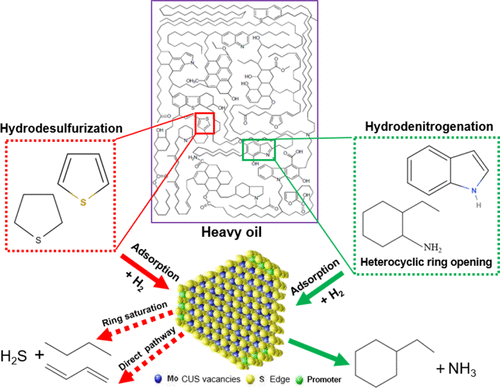当前位置:
X-MOL 学术
›
Energy Fuels
›
论文详情
Our official English website, www.x-mol.net, welcomes your
feedback! (Note: you will need to create a separate account there.)
A Review on the Reaction Mechanism of Hydrodesulfurization and Hydrodenitrogenation in Heavy Oil Upgrading
Energy & Fuels ( IF 5.2 ) Pub Date : 2021-06-24 , DOI: 10.1021/acs.energyfuels.1c01015 Suleiman Sabo Bello 1, 2 , Chao Wang 1 , Mengjuan Zhang 1 , He Gao 1 , Zhennan Han 1 , Lei Shi 1 , Fabing Su 2 , Guangwen Xu 1
Energy & Fuels ( IF 5.2 ) Pub Date : 2021-06-24 , DOI: 10.1021/acs.energyfuels.1c01015 Suleiman Sabo Bello 1, 2 , Chao Wang 1 , Mengjuan Zhang 1 , He Gao 1 , Zhennan Han 1 , Lei Shi 1 , Fabing Su 2 , Guangwen Xu 1
Affiliation

|
The future of fuel supply will undoubtedly involve the utilization of heavy crude oils, including those from nonconventional sources, such as bitumen and oil shale. Because of their dense nature and poor compositional characteristics, heavy oils cannot be admitted straightly as refinery feeds, since the direct processing of such oils hardly produces engine fuels of commercial standard. The currently available refinery setups also require substantial retrofitting in order to process such heavy feeds. Thus, heavy oils must undergo an initial upgrading called hydrotreatment (HDT) by which the feeds are converted to qualified fuel oils or synthetic crude (syncrude) for easy handling. Removing the considerable amount of sulfur (S) and nitrogen (N) compounds present in the heavy crude oils selectively by hydrodesulfurization (HDS) and hydrodenitrogenation (HDN), respectively, is among the most critical and challenging aspects of the upgrading. However, the mechanism of these two reactions, in relation to different catalytic sites, temperature, pressure, and other operation variables, is not fully understood or well-documented. By analyzing the possible reaction routes involved in S and N removal by HDT, this review sets to bridge the gap that has been left void for a long period of time, to serve as a guide for innovative heavy crude oil upgrading technologies. It finally reports the current challenges impeding the speedy inclusion of heavy crude oils into the global oil supply stream, and proffer perspective solutions together with future research trends.
中文翻译:

稠油改质加氢脱硫加氢脱氮反应机理综述
燃料供应的未来无疑将涉及重质原油的利用,包括来自非常规来源的重质原油,如沥青和油页岩。由于重油的稠密性质和较差的组成特性,重油不能直接作为炼油厂进料,因为这些油的直接加工很难生产出商业标准的发动机燃料。当前可用的炼油厂设置也需要大量改造才能处理如此重的进料。因此,重油必须经过称为加氢处理 (HDT) 的初始升级,通过该升级将进料转化为合格的燃料油或合成原油(合成原油),以便于处理。分别通过加氢脱硫 (HDS) 和加氢脱氮 (HDN) 选择性地去除重质原油中存在的大量硫 (S) 和氮 (N) 化合物,是升级中最关键和最具挑战性的方面之一。然而,这两个反应的机理与不同的催化位点、温度、压力和其他操作变量有关,尚未完全了解或有据可查。本综述通过分析 HDT 脱硫脱氮的可能反应路线,弥补长期以来的空白,为创新重质原油提质技术提供指导。它最终报告了当前阻碍重质原油快速纳入全球石油供应流的挑战,
更新日期:2021-07-15
中文翻译:

稠油改质加氢脱硫加氢脱氮反应机理综述
燃料供应的未来无疑将涉及重质原油的利用,包括来自非常规来源的重质原油,如沥青和油页岩。由于重油的稠密性质和较差的组成特性,重油不能直接作为炼油厂进料,因为这些油的直接加工很难生产出商业标准的发动机燃料。当前可用的炼油厂设置也需要大量改造才能处理如此重的进料。因此,重油必须经过称为加氢处理 (HDT) 的初始升级,通过该升级将进料转化为合格的燃料油或合成原油(合成原油),以便于处理。分别通过加氢脱硫 (HDS) 和加氢脱氮 (HDN) 选择性地去除重质原油中存在的大量硫 (S) 和氮 (N) 化合物,是升级中最关键和最具挑战性的方面之一。然而,这两个反应的机理与不同的催化位点、温度、压力和其他操作变量有关,尚未完全了解或有据可查。本综述通过分析 HDT 脱硫脱氮的可能反应路线,弥补长期以来的空白,为创新重质原油提质技术提供指导。它最终报告了当前阻碍重质原油快速纳入全球石油供应流的挑战,































 京公网安备 11010802027423号
京公网安备 11010802027423号